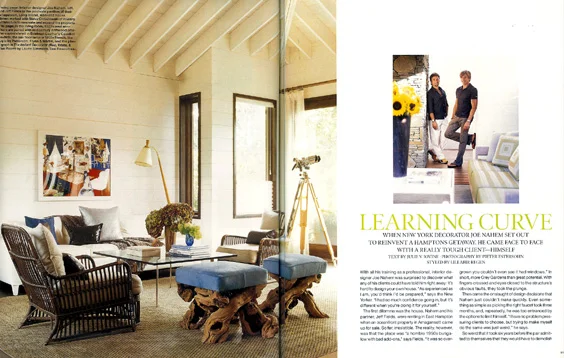See All Photos
Elle Décor July/Aug '06, "Learning Curve"
pages 110-119 by Julie V. Iovine
With all his training as a professional, interior designer Joe Nahem was surprised to discover what any of his clients could have told him right away: it's hard to design your own house. "As experienced as I am, you'd think I'd be prepared," says the New Yorker. "I had so much confidence going in, but it's different when you're doing it for yourself."
The first dilemma was the house. Nahem and his partner, Jeff Fields, were renting in East Hampton when an oceanfront property in Amagansett came up for sale. So far, irresistible. The reality, however, was that the place was “a horrible 1950's bungalow with bad add-ons,” says Fields. “It was so over-grown, you couldn’t even see it had windows.” In short, more Grey Gardens than great potential. With fingers crossed and eyes closed to the structure’s obvious faults, they took the plunge.
Then came the onslaught of design decisions that Nahem just couldn’t make quickly. Even something as simple as picking the right faucet took three months, and, repeatedly, he was too entranced by the options to limit himself. “I have no problem pressuring my clients to choose, but trying to make myself do the same was just weird,” he says.
So weird that it took six years before the pair admitted to themselves that they would have to demolish most of the house in order to make it live up to their expectations. Nahem and Fields tried to keep the key elements very simple: They wanted as much natural light as possible, and the quality of the doors, hardware, and windows had to be the best. “Those are the kids of details that give away the whole story at a glance,” say Nahem, adding that he often lectures clients on the importance of using top–of-the-line materials. “Get them right and everything else will look great by association.”
Even though the cost often made him cringe, Nahem never stinted. The shingles on the roof are hand-split cedar, and the door and window frames are all solid mahogany. Instead of Sheetrock, interior walls are paneled in cypress or painted clear pine, while the ceilings are whitewashed knotty pine. The floors are reclaimed oak that was remilled, stained, and oiled, rather than coated in shiny polyurethane. The idea of all that textured wood was to give the place a feeling of substance. “We didn’t want anything to shriek ‘new’” says Fields. Even the limestone floor that runs from the entry to the kitchen is recycled from a French chateau.
Architecturally, the one-story house was modest, with deep overhangs allowing for generous porches. Desiring more space and better views of the ocean, Nahem turned to a friend, the New York architect Steve Chrostowski, to create a second floor encompassing a master bedroom suite and guest bedroom. “We knew what we’d be getting because we used to go up on the roof to check out the view,” Nahem says. “The first time, my eyes teared just climbing up the ladder.”
The additional height also allowed Nahem to realize his longtime dream of building a towering, two sided fireplace. Though the contractors tried to dissuade him from devoting so much space and energy on one gesture, the designer went ahead anyway, creating a riveting centerpiece that divides the living room into two distinct areas. One side is for sprawling in front of the television; the other has formal seating designed by Nahem for entertaining.
And then there was the cardinal rule: Don’t buy something unless you know where it’s going. That concept went out the window. “We just bough whatever we loved,” he says. Ultimately, the list included everything form a floor lamp adorned with a full-size marlin to a white vinyl sofa found at a yard sale and a Nakashima cocktail table bought at auction. Now, visitors to the house notice different things. Some take in the expensive, wood-frame windows and overscale sliding doors and say the place has a California vibe; others discover an Asian feel in the Nakashima pieces, including a kitchen counter commissioned from the late furniture maker’s daughter, Mira. Either way, everyone notices the serenity of the house that belies years of carefully editing limitless desires into final choices. “All I know,” says Nahem, “is that every time I pull into the driveway, I wonder, How did we ever pull this off?”





